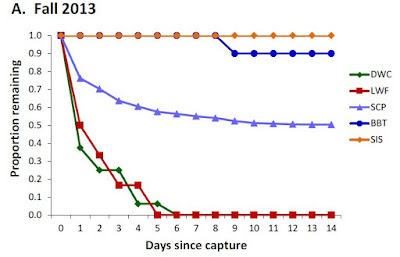Friday, December 4, 2015
New publication in Journal of Great Lakes Research
link to article
My master's work on the foraging characteristics of siscowet lake trout has just been published.
Thursday, November 26, 2015
Collection of Deepwater Fishes: Dealing with Barotrauma
Part of my research involves the collection of deepwater fishes from the cold waters of Lake Superior. With the help of Owen Gorman and the folks at the Ashland, USGS, we make sure we have numerous, healthy fish for our experiments.
Our fish are collected via deepwater trawls aboard the USGS research vessel, the KIYI. The fish of interest are brought up from 120 meters (~400ft) and much like scuba divers, rising too quickly to the surface can cause problems. Boyle's law that states that the volume a of gas is inversely proportional to the pressure, meaning that the gasses within fish expand as they move shallower. This internal damage is known as barotrauma (baro=pressure, trauma=damage), and is most apparent in the expansion of the swim bladder and bursting of capillaries within tissues.
 |
| With every 10 meters ascent, the volume of a gas doubles. Here we see a lake trout moving from 20 meters to the surface exhibiting a tripling in the volume of the swim bladder. |
 |
| A siscowet lake trout showing typical barotrauma |
Collected fishes typically show multiple signs of barotrauma including: exopthalmia (bulging eyes), bloated bodies (swim bladder expansion) and tissue damage from ruptured capillaries. There is also internal damage that is less obvious such as the nephron of the kidney rupturing.
While siscowet are hardy and we have not had any mortalities associated with barotrauma, some fish, like deep water coregonines (Kiyi) do not survive once captured.
The graph on the left shows survival of collected fishes in days since captured. Here we see siscowet (SIS) have 100% surival, deepwater sculpin (SCP), 50% and Kiyi (DWC) do not live past 5 days.
In an effort to help alleviate barotrauma, Owen Gorman with the USGS created a hyperbaric vessel to quickly repressurize fish once captured, and then slowly depressurize them. I hleped test the efficacy of this apparatus, known as the HAfF (Hyperbaric Aperatus for Fishes) this fall on Lake Superior.
 |
| HAfF aboard the RV Kiyi |
 |
| Checking the valves before pressurization |
 |
| Decompressed vs. non-decompressed siscowet lake trout |
Collected fishes are slightly anesthetized with MS222, and added to the HAfF (A above). Pressure and mixtures of gasses are monitored from inside the ship via a control panel (B above). We can monitor fish activity with a cameras mounted inside the pressure chambers on the HAfF (C & D above).
Dr. Gorman and I are currently writing up a report for the Great Lakes Fisheries Commision. We have seen marked improvement in the condition of siscowet lake trout since implementing the HAfF. Siscowet that have been decompressed show less tissue damage (A & B right) and show increased activity and feeding sooner. As a comparison, a non-decompressed siscowet lake trout (C & D right) shows obvious signs of barotrauma.
Wednesday, October 14, 2015
Siscowet Lake Trout Foraging Trials
 Below is actual footage from a few of our foraging trials that show Siscowet Lake Trout foraging for Golden Shiners. We analyze the footage looking for a set of foraging parameters or behaviors to determine how Siscowet manage to forage for prey at varying light intensities.
Below is actual footage from a few of our foraging trials that show Siscowet Lake Trout foraging for Golden Shiners. We analyze the footage looking for a set of foraging parameters or behaviors to determine how Siscowet manage to forage for prey at varying light intensities.
Video 1 shows the initiation of a trial with the lifting of the foraging arena gate that separates predator and prey. Trials last 10 mins or until prey is consumed.
Video 2 breaks down the foraging parameters that we look for while analyzing footage. A couple parameters we examine are reaction distance and angle of attack, We also look at whether trout capture prey and the time to capture.
Video 3 Siscowet lake trout are able to sense their prey via mechanosensory detection (lateral line) in the dark. This video shows how the trout are able to detect and follow their prey, but rarely capture prey in absolute darkness.
Video 4 The siscowet lake trout is able to detect prey movements within half the total length of its body. We see here that the siscowet does not detect the prey until it is within half a body length, and then quickly loses the prey when out of range. Trial in absolute darkness (0 lux).
Friday, September 18, 2015
Sea Grant Radio Guest
Burbot Radioshow Link
http://www.seagrant.umn.edu/audio/2015.09.15_burbot.mp3
This week I was a guest on the Sea Grant Radio Show entitle Burbot and the lota lota. I talked with Olivia Dehler about the Burbot's history in Lake Superior and their current state.
Aired September 15, 2015.
http://www.seagrant.umn.edu/audio/transcripts/2015.09.15_burbot.pdf
http://www.seagrant.umn.edu/audio/2015.09.15_burbot.mp3
This week I was a guest on the Sea Grant Radio Show entitle Burbot and the lota lota. I talked with Olivia Dehler about the Burbot's history in Lake Superior and their current state.
Aired September 15, 2015.
http://www.seagrant.umn.edu/audio/transcripts/2015.09.15_burbot.pdf
Tuesday, September 15, 2015
Lake Superior Basics
Worked with Sharon Moen from MN Sea Grant to create a small piece for Northland News Center- channel 3, KBJR on Lake Superior Fishes. Aired September 9, 2015.
Sea Grant Blurb: Superior's fish are all part of an interconnected food web. The top predators like Lake Trout have to hunt their prey. Some species find dinner deep under the surface and in low-light environments. To learn more about Superior’s offshore food web we talked to Trevor Keyler, a PhD. candidate at the University of Minnesota-Duluth.
Monday, August 31, 2015
Portland Bound
Subscribe to:
Posts (Atom)






